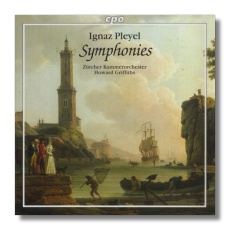
The Internet's Premier Classical Music Source
Related Links
- Latest Reviews
- More Reviews
-
By Composer
-
Collections
DVD & Blu-ray
Books
Concert Reviews
Articles/Interviews
Software
Audio
Search Amazon
Recommended Links
Site News
 CD Review
CD Review
Ignaz Pleyel

Symphonies
- Symphony in D Major, Op. 3 #1
- Sinfonia Concertante "2ème Symphonie Concertante" in F Major for Violin, Piano & Orchestra
- Symphony in F Major "6ème Symphonie Périodique", Op. 27
Jakub Dzialak, violin
Riccardo Bovino, piano
Zürich Chamber Orchestra/Howard Griffiths
CPO 999759-2 DDD 55:09
Poor Ignaz Pleyel (1757-1831): his reputation isn't half what it used to be. At one time the pupil – and then the London rival – of Franz Joseph Haydn, he was thought to be superior to his mentor by no less a figure than Robert Schumann. Pleyel once was the human symbol of everything balanced and moderate in symphonic music. Even on Cape Cod (Nantucket, to be exact), a Pleyel Society was founded "to purify the taste of the public." Today, his name is recognized for the Parisian concert hall to which it is attached (the Salle Pleyel), and for the pianos that he (and later, his son) had manufactured under the family name, beginning in 1807. Another nugget worth retaining is Pleyel's invention of the miniature score – an innovation associated with the publishing house he founded in the mid-1790s. How did Pleyel have the time for all of this "extracurricular" activity? He did it in the style of Rossini or Sibelius, by giving up composing for about the last thirty years of his life.
Pleyel was alive during Beethoven's entire lifetime, almost all of Mozart's lifetime, and for much of Haydn's lifetime. It is not a surprise, then, that echoes and pre-echoes of all three composers – with all of the charm but without much of the genius – can be heard in his work. Thematically, the finale of the Symphony in D (1785) anticipates the parallel movement of Mozart's Symphony #39, written just three years later. (cpo's annotator compares this same movement to the finale of Beethoven's First Symphony – also a valid comparison.) The opening of the Symphonie Concertante (1802-05) sounds like a forgotten Mozart piano concerto, and in fact, there are some thematic similarities between this music and the finale of Mozart's Piano Concerto #21. In the finale, however, Pleyel does something that Mozart never did: he has his soloists break out into a good Irish jig – a souvenir of his time in London a decade before? Some of the same spirit informs the Haydnesque opening of the 6ème Symphonie Périodique, which Pleyel wrote in 1788. (Bert Hagels's otherwise excellent annotations do not explain why this symphony is "périodique.")
I enjoyed a disc of music by Beethoven's pupil Ferdinand Ries with these same performers (CPO 999716-2), and the good impression made there is preserved here: this is warm-blooded, stylistically appropriate, and – most important – excitedly communicative playing. The Zürich Chamber Orchestra is a modern instruments ensemble with a full but transparent sound. I can't imagine anyone bettering them and conductor/artistic director Howard Griffiths soon. Pleyel's music might not be earth-shattering, but it deserves the first-class treatment that it receives here.
Copyright © 2002, Raymond Tuttle



















